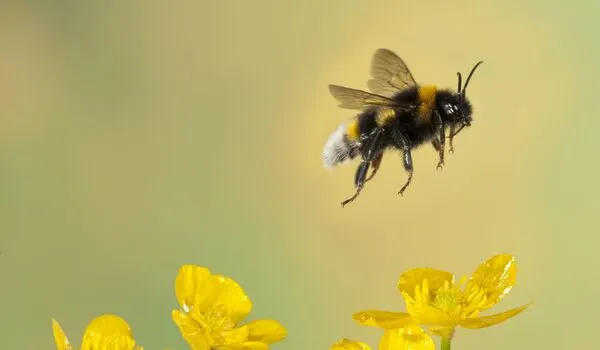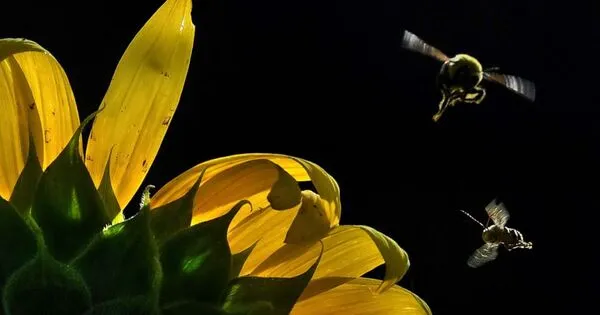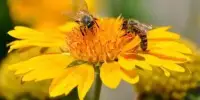While bees are frequently highlighted as pollinators, moths also play an important role in pollination and ecosystem health. Indeed, they are frequently regarded as one of the most important groups of nocturnal pollinators. Moths, like bees, pollinate a wide range of plant species, including many flowers that bloom at night. They are drawn to the nectar and fragrance of flowers, and as they feed, they transport pollen from one flower to another. Plants can reproduce and produce seeds as a result of this process, ensuring the survival of many plant species.
A new study from the University of Sheffield suggests that night-time pollinators like moths visit the same plants as bees and should be the focus of conservation and protection efforts.
The study discovered that moths under urbanization pressure may be less resilient than bees due to their more complex life cycle and more specific plant requirements. Despite this threat, moths play an important role in supporting urban plant communities, accounting for one-third of all pollination in flowering plants, crops, and trees.
According to the researchers, when planning or redeveloping urban areas, supporting the introduction of plant species that are beneficial to moths and bees will become increasingly important for the health of urban ecosystems.
Our study found that in more urbanized areas, the diversity of pollen being carried by moths and bees decreases, meaning that urban pollinators may have fewer flower resources available to them.
Dr. Emilie Ellis
“Our study found that in more urbanized areas, the diversity of pollen being carried by moths and bees decreases, meaning that urban pollinators may have fewer flower resources available to them,” said Dr. Emilie Ellis, lead author from the University of Sheffield’s Grantham Institute for Sustainable Futures and now the Research Centre for Ecological Change (REC) at the University of Helsinki.
“In the same way that moths and bees rely on plants for survival, plant populations rely on insects for pollination.” Protecting urban green spaces and ensuring that they are developed in a way that goes beyond bee-only conservation and supports a diverse range of wildlife will ensure that both bee and moth populations remain resilient, and our towns and cities remain healthier, greener places.”
In the study, Dr. Ellis and her co-authors showed that bees and moths are visiting significantly different plant communities. Along with the usual pale and fragrant flower species moths are known to frequent, the study showed that moths were found to be carrying more pollen than previously thought, and visiting more types of tree and fruit crops than previously identified.

In urban areas, there may be an overabundance of non-native plant species, or simply a reduction in plant species diversity; this may result in lower insect interactions for less attractive plant species, having a negative impact on both plant and insect populations.
Dr. Ellis says the study shows how important moths are at pollinating plants, including crops, and that it has implications for wildlife-friendly gardening initiatives, urban planners, and policymakers in charge of developing urban green spaces for parks or urban horticulture.
“People don’t generally appreciate moths, so they can often be overlooked when talking about protection and conservation when compared to bees,” said Dr. Ellis. “However, it’s becoming clear that there needs to be a much more focused effort to raise awareness of the important role moths play in establishing healthy environments, especially given that moth populations have drastically declined over the past 50 years.”
“When designing green spaces, care must be taken to ensure that planting is diverse, moth-friendly, and bee-friendly, in order to ensure that both our plants and insects remain resilient in the face of the climate crisis and further losses.”
Dr Stuart Campbell, from the University of Sheffield’s School of Biosciences, and a senior author on the study, said: “Most plants depend on insects for pollination, but knowing which insects do the pollinating is actually a really difficult question to answer. There are about 250 species of bee in the UK, and we know quite a bit about some of these species, but we also have over 2,500 species of moth which visit flowers mostly at night. So, as you might expect, we know a lot less about these.
“In this study, we were able to use DNA sequencing to identify the pollen that gets stuck to night-flying moths when they visit flowers.” We discovered that moths are likely pollinating a variety of plant species, many of which are wild, that bees are unlikely to pollinate – and vice versa. This study shows that pollination is accomplished by complex networks of insects and plants, and that these networks may be delicate and vulnerable to urbanization. We can also learn which plant species provide the best food for different insects, including nocturnal ones like adult moths, and use that knowledge to better provide for all of our pollinators.”
















